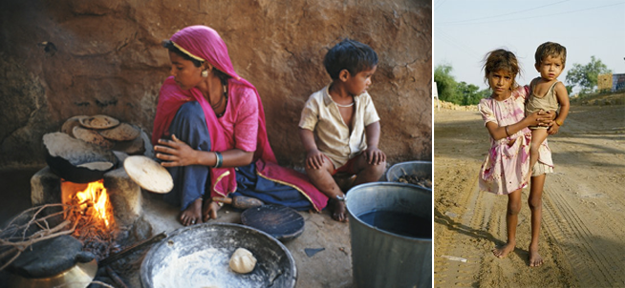Dec 23, 2025
Dec 23, 2025
The Planning Commission of India reports that the nation’s poverty rate has dropped by seven percentage points in five years, from 37 percent in 2005 to 30 percent in 2010. How did this hard-to-believe steep decline come about? Perhaps, it occurred by lowering a benchmark the commission uses to count poor people living below the poverty line. Last year the Singh government lowered the amount needed per day to live to Rs.32 (US$0.64) or less in city areas and Rs.26 (US$0.52) or less in rural areas. Earlier these amounts were Rs.35 or less and Rs.28 or less respectively. Thus, thousands were removed from the poverty statistics.

The government’s benchmark amount is too low; it is solely based on the amount of money it takes to buy a meal or two per day. It does not take into account the money needed for other essentials such as clothes, shelter, personal hygiene, and health care.
The commission also states that 30 percent of the people live below the poverty line, representing 36 crore (360 million) people out of 120 crore (1.2 billion) Indians. This figure is substantially smaller than the World Bank’s estimates of 83 crore (830 million). Furthermore, it indicates that the poverty rate has declined by 7 percent, meaning 8.4 crore (84 million) people are no longer poor, more than some countries’ entire population.
Both statistics are unbelievable: it takes more than Rs.32 per day to live, and it is hard to believe that 8.4 crore are no longer destitute. The government is playing with data for two purposes: one, to show that fewer people are now living below poverty line, and secondly, to qualify fewer people for government aid.
Takes Time
A nation’s economic policies and programs affect the poverty rate, and it takes time to see the results of the government’s actions. A steady implementation of productive policies lowers the rate, and conversely, destructive policies raise the rate. It took the USA 28 years to lower the number of families below the poverty line by 22.3 percent (from 32 percent in 1947 to 9.7 percent in 1975).
Table 1: Change in Population below Poverty Line (PBPL) in Percent
| Country | Beg Year |
Beg. PBPL |
End Year |
End PBPL |
# of Year |
Change | Avg.Chg Per Year |
| France | 2000 | 6.5% | 2004 | 6.20% | 4 | -0.30% | -0.08% |
| Germany | 2001 | 11.0% | 2010 | 15.50% | 9 | +4.50% | +0.50% |
| Malaysia | 2002 | 5.1% | 2007 | 3.60% | 5 | -1.50% | -0.30% |
| Turkey | 2002 | 20% | 2008 | 17.11% | 6 | -2.89% | -0.48% |
| USA | 2001 | 12.7% | 2003 | 12.00% | 2 | -0.70% | -0.35% |
Source: CIA World Factbook and indexmundi.com
Table 1 Column 8 indicates that the poverty rate changes very slowly, and this is why it is hard to believe the Indian government’s claim that it has reduced poverty at the rate of 1.4% per year (7 percent divided by 5 years) from 2005 to 2010.
08-Apr-2012
More by : Vasant G. Gandhi

|
Mr. Bohre, You have a valid point. Our government manipulates statistics to show we have made progress, in your worlds, "towards prosperity". Many in media go along with the people in power, however, the reality, as some of us know, is different. |

|
Sir, These official figures are prepared to be used in indirect electon campaingns. Soon, there will be 'analysis' and 'opinion' on various news papers, especially local papers claiming that the country has moved towards prosperity. Those news papers will shamelessly publish such opinion in order to favour the corrupts in power. And common 'literate' man will be made to agree to it, they will be made to believe that UPA govt did a wonderful job. Indirect campaigns have no opponents, no challenging voices. |